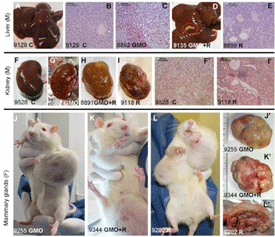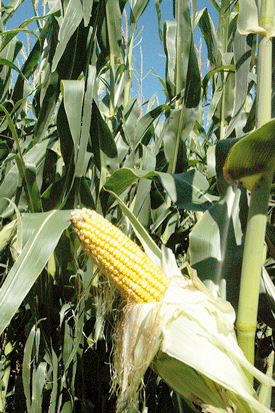GMO Study Retracted - Censorship or Caution?
Air Date: Week of December 6, 2013

Roughly 80% of the corn grown in the US is genetically modified. (Photo: Victor Bayon)
A French study in 2012 led by Gilles-Eric Séralini found animals fed Monsanto’s Roundup Ready corn had increased mortality and more tumors than a control group. Amid heavy industry criticism, the journal that published the research has retracted the study from its archives. Host Steve Curwood talks to Michael Hansen, a senior scientist at Consumer’s Union, who views the retraction as a form of censorship.
Transcript
CURWOOD: Roughly 60 percent of corn grown in the US is genetically modified to resist Monsanto's herbicide Roundup. Last year, Gilles-Eric Seralini, a French scientist, found that rats fed a steady diet of Roundup-ready corn had more tumors and died earlier than rats in a control group. Monsanto objected, saying the study did not meet minimum accepted standards for this type of scientific research. Now the Journal Food and Chemical Toxicology, that published the Seralini study, has decided to retract it. For some clarification, we turn now to Michael Hansen, Senior Scientist at Consumer’s Union. Welcome to Living on Earth, Michael.
HANSEN: Glad to be with you.
CURWOOD: So first off, why was this study so controversial? What were the criticisms of the research here?

Séralini’s paper includes these photos of tumors found in rats that ate genetically modified corn and Roundup. (Séralini et al)
HANSEN: The main criticism was that the number of rats that they tested per group, ten rats, was too small for a cancer study, that you should at least be using 50 rats and they said that the strain of rat that was used, Sprague-Dawley rats, are prone to tumors. So those were the two main criticisms, and neither of them are really valid.
CURWOOD: Why do you say neither of those criticisms are valid?
HANSEN: Well, basically what Dr. Séralini did was he did the same feeding study that Monsanto did and published in the same journal eight years prior, and in that study, they used the same number of rats, and the same strain of rats, and came to a conclusion there was no problem. So all of a sudden, eight years later, when somebody does that same experiment, only runs it for two years rather than just 90 days, and their data suggests there are problems, that all of a sudden the number of rats is too small? Well, if it’s too small to show that there’s a problem, wouldn’t it be too small to show there’s no problem? They already said there should be a larger study, and it turns out the European Commission is spending 3 million Euros to actually do that Séralini study again, run it for two years, use 50 or more rats and look at the carcinogenicity. So they’re actually going to do the full-blown cancer study, which suggests that Séralini’s work was important, because you wouldn’t follow it up with a 3 million Euro study if it was a completely worthless study.

(Photo: Kay Ledbetter)
CURWOOD: So now the Journal Food and Chemical Toxicology has put out a statement saying, “no definitive conclusions can be reached with this small sample size.” That’s at least part of the reason for removing the study. How do you respond to that?
HANSEN: Well, if that’s their criteria, many articles that are in the scientific literature find somewhat equivocal results. You wouldn’t say that the paper should be retracted because some data was inconclusive.
CURWOOD: So, Mike, what would be the appropriate circumstances for retracting a scientific study from a journal like this?
HANSEN: The appropriate reasons for retracting a journal article, those have been agreed upon by...there’s this committee on publication ethics, and it should be pointed out that Food and Chemical Toxicology is a member of that organization. When you look at their guidelines, they say there’s only three reasons to retract a paper. One, clear evidence that the findings are unreliable due to misconduct, that is, data fabrication or honest error. Two, plagiarism or redundant publication. Three, unethical research. In the letter that the editor of Food and Chemical Toxicology, Dr. Wallace Hayes sent to Dr. Séralini, they admitted that they found no problem with plagiarism, unethical research or data fabrication. There was no problem there. They just said they were going to withdraw it because there was some data that was “inconclusive,” particularly the number of animals used and the strain of rat used.
CURWOOD: So, you’ve been in the science business for a good while. Why do you think they retracted this article?
HANSEN: Well, there has been a campaign to try to get them to retract this article ever since it came out. Folks in the industry, and very pro-biotech scientists...they’ve attacked this paper, there’s been a campaign of vilification, this almost appears as some kind of retaliation against papers that try to find problems with genetically-engineered foods. It should be pointed out that since this controversy started last year with the publication of this paper, the Journal Food and Chemical Toxicology brought on an assistant editor to deal with the biotechnology, and it’s a scientist, Dr. Goodman, who used to work in regulatory sciences for Monsanto and they’ve actually retracted another paper by Brazilian researchers that looked at the potential adverse health impact of engineered bacteria, and so this is now the second paper that has to do with genetic engineering that this journal is retracting, and it raises issues of why they would do this. And it appears what they’re trying to do, it’s almost like an act of scientific censorship because when a paper is retracted, it disappears, it’s as though it’s never been published. And it makes me wonder, are we in the Soviet era, and people are trying to rewrite history?
CURWOOD: Now as I understand it, the Séralini work is one of among only very few studies that have been conducted by independent scientists as opposed to industry scientists when it comes to the question of Roundup. How correct is that?
HANSEN: Well, that is actually fairly correct. There was an article published in 2011 in the Journal of Food Policy that was actually very interesting because it looked at this issue of conflict of interest, both financial conflict and professional conflict of interest. And for articles in which there was a professional conflict of interest, there were 41 studies, and that means one or more of the authors in each of the studies worked in the industry. Of those 41 studies, every single one of them found no problem. For studies where there was not a professional conflict, that is where none of the authors came from industry, there were 51 studies, 12 of them found problems. That was a highly statistically significant difference, the probability of that happening by chance was less than one in 1000, was less than .001. So what that suggests is that if a study on GMOs involves an industry scientist, if they’re an author on it, it will invariably find no problem at all with the GMO.
CURWOOD: So at the end of the day, Mike, what is the scientific consensus about the safety of people who eat food treated with roundup?
HANSEN: There is no scientific consensus on the health impacts of eating foods treated with Roundup. However, there is data that does link Roundup levels to non-Hodgkin’s Lymphoma, and there’s evidence that there might be birth defects. Those are the two issues that have been related to Roundup and that need to be looked at further.
CURWOOD: Mike Hansen, Senior Scientist at Consumer’s Union. Thanks so much, Mike, for taking the time.
HANSEN: Thank you.
Links
Monsanto comments on the Séralini study
Original Séralini study published in 2012
Listen to the original LOE story on the Séralini story
Read the Journal Food and Chemical Toxicology statement about the retraction
Living on Earth wants to hear from you!
Living on Earth
62 Calef Highway, Suite 212
Lee, NH 03861
Telephone: 617-287-4121
E-mail: comments@loe.org
Newsletter [Click here]
Donate to Living on Earth!
Living on Earth is an independent media program and relies entirely on contributions from listeners and institutions supporting public service. Please donate now to preserve an independent environmental voice.
NewsletterLiving on Earth offers a weekly delivery of the show's rundown to your mailbox. Sign up for our newsletter today!
 Sailors For The Sea: Be the change you want to sea.
Sailors For The Sea: Be the change you want to sea.
 The Grantham Foundation for the Protection of the Environment: Committed to protecting and improving the health of the global environment.
The Grantham Foundation for the Protection of the Environment: Committed to protecting and improving the health of the global environment.
 Contribute to Living on Earth and receive, as our gift to you, an archival print of one of Mark Seth Lender's extraordinary wildlife photographs. Follow the link to see Mark's current collection of photographs.
Contribute to Living on Earth and receive, as our gift to you, an archival print of one of Mark Seth Lender's extraordinary wildlife photographs. Follow the link to see Mark's current collection of photographs.
 Buy a signed copy of Mark Seth Lender's book Smeagull the Seagull & support Living on Earth
Buy a signed copy of Mark Seth Lender's book Smeagull the Seagull & support Living on Earth

